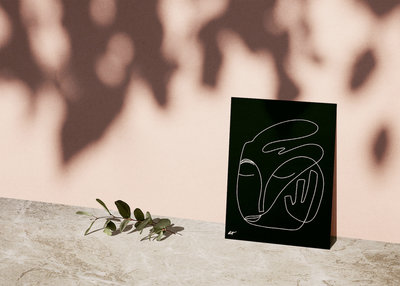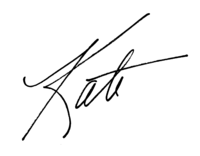

Twenty years ago I was a college senior about to graduate with degrees in English and history. During my last semester, a professor teaching a class on Chinese history put up the grade breakdown on the chalkboard (yep…chalkboard).
It went like this: A, A-, B+, B, B- and so on.
I asked, “Why is there no A+?”
She replied, “I’ve never, in my entire teaching career, met a student whose work merited an A+.”
Challenge accepted.
I spent the better part of two months in the library stacks on campus, piles of books on Mao’s Great Leap Forward crammed into a tiny study carol. It was a room no bigger than a public toilet stall, with a tiny window, a desk, chair and nothing else. Nothing.
This was before personal internet connection, laptops or smartphones. I had pens, highlighters, note cards, books, and paper. I took fruit as my snack. I didn’t even drink coffee back then.
I read, took notes and highlighted said notes in three-hour chunks. Then, I got up and walked around the library, maybe got a Chick-fil-A sandwich and got back to work. I did this several times a week.
Twenty years later, I can’t even read an entire online article without stopping to check e-mail, read a text message, get a cup of coffee or wander over to E-bay to see if an Ace & Jig dress might have come available for under $100.
“With the onslaught of personal technology, the multi-tasking of motherhood and the beauty of aging, my attention span had taken a nosedive the likes of which left me perpetually frazzled, unproductive and frustrated.”
Why couldn’t I enjoy a book anymore? Why was it taking me forever to get through one chapter? Why couldn’t I watch a television show without looking at my phone? Why did reading a bedtime story seem like it took twenty minutes when, in reality, it was less than five? Why couldn’t I carry-on meaningful conversations over lunch without looking around the room, wondering if I just heard my phone ding or making a mental list of all the stuff I had left to do that afternoon?
As I noticed this phenomenon in my own life and in the people around me, from my kids to my friends to even my parents, I began researching ways to address my apparent attention deficit and began building a slow, sustainable program to strengthen my focus, deepen my attention and quiet my mind.
How did I do it?
It hasn’t been an easy, linear or simple road. I’ve read a lot of books on the subject, listened to TED talks, sifted through articles and studies and gone through a lot of trial and error.
But as I’ve applied new ideas, techniques and rules for my own life, I’ve discovered it’s entirely possible to focus in a world that is often chaotic and to mine for more meaningful work, relationships and experiences in a society that often feels superficial.


Here are 7 Tips for Building and Sustaining Focus:
1. Make Lists.
I learned this from the book Getting Things Done: The Art of Stress-Free Productivity. Lists aren’t just to-do tally sheets; they enable us to get all of that must-do, should-do, want-to-do clutter from our brains and onto paper, which means we can forget about it and focus on other stuff. I think of it like a background app running on my phone or computer. It’s in the background, yes, but it still takes up space and speed. Writing lists (from daily to-do to long-term goals to when to pay bills) is like closing out browser tabs. Now, whenever I feel disoriented, distracted or unfocused, I sit down, write a list and take a breath. It’s seriously magic.
2. Create Distraction-Free Zones.
Depending on the work I do, I am distracted by different things. If I need to write, I’ll be distracted by the internet, phone calls, even laundry. So, I write away from home. If I need to do housework/chores, I will be distracted by eating, phone calls or the Internet. So, I put on Audible, which distracts me from my other distractions but enables me to scrub floors or fold laundry. The point is to know which distractions you’re facing for each task you’re trying to accomplish and deal with those specific distractions. Have a plan. Create a zone. Your zones will be different depending on the task, but limiting distractions is key to being able to focus.
3. Limit Low-Level Interaction Across the Board.
There are many levels of interaction. There is low-level television, reading, eating and conversation. And, of course, there is higher-level interaction in all of these realms and beyond. When I stopped reading useless articles online and focused my attention, even in my downtime, on higher-quality material, I noticed my brain trained to look for that all the time. I was more engaged mentally, rather than simply surfing and filtering junk, and my brain seemed to take this baseline and reset. If I wanted to be able to focus on higher-quality engagement for certain parts of my life, I needed to keep that baseline the majority of the time, not only when I was working on a writing project or reading a classic novel. As I’ve raised my standards in terms of what I’m willing to engage with, my focus and attention have strengthened as well.
4. Make the Most of Downtime.
This speaks to the above point about higher-quality engagement, but when I stopped viewing my downtime as disposable, throw-away time, life got a lot more interesting. Baths are now the perfect time to read a chapter of a great novel instead of celebrity gossip on my phone. Waiting in the car line at school pick-up is a time to close my eyes and meditate for a few minutes or focus on my breath. While I cook I listen to jazz instead of kids arguing in the background. I don’t view any of my time as throw-away anymore, and the result has been dramatic. Instead of swinging between periods of deep engagement and utter disengagement, our brains will find a much more stable equilibrium when we remain engaged even during our downtime.
5. Practice Blistering Intensity.
In his book entitled Deep Work, Cal Newport suggests building focus through practice, particularly in working with ‘blistering intensity.’ This is the kind of work I did back in college, trying so hard for that A+. I focused intensely for hours on one subject, tuning out everything outside of that tiny study cubicle. Recognizing I’ve lost the ability to focus with blistering intensity, I began (as Newport suggests) to build it back up with scheduled sessions. I chose reading as my training program; though you might choose coding, cooking, gardening, etc. The point is to practice focusing intensely for longer and longer periods of time. I first began reading and found I could only read without distraction for about seven minutes. Seven! I committed to practicing once a week, and within a month I was reading for a solid half-hour before becoming distracted. I’ve worked my way up to an hour for novels and an hour-and-a-half for research. It takes time and effort, but like training any other muscle, with consistency, you can get back to intense, blistering focus.
6. Schedule Distraction.
I used to think I needed to schedule my time for priorities and getting things done, but I’ve learned that what I really need to schedule and pay attention to are the things that distract me. I now set aside time to check email, make online purchases, talk on the phone or FaceTime with family. When I began scheduling those activities that often end up distracting me, they stopped tempting me throughout my day. I knew I’d get to email at a certain time, so the temptation to check it throughout the day lessened noticeably. Scheduling distractions keeps them in check and enables us to move on with our day without distraction FOMO.
7. Start Single-Tasking.
We like to glorify two things: multi-tasking and busyness. Neither is effective, and I’ve found both to be the ultimate distractors. Multi-tasking, for me, means doing nothing well. Yes, I’m “busy,” but I’m not productive. What’s more, I often make mistakes through multi-tasking and spend more time repeating my work. Beyond that, I feel pressure and stress from overcommitting, even if it’s just to multiple tabs on my browser. Now, I single-task. If I’m doing the dishes, I do the dishes. I also complete tasks fully. I don’t do half of the dishes or half the bathroom or write half an article. I decide what my objective is, focus entirely on that one thing and finish it to completion. The results are amazing. I feel such a stronger sense of accomplishment, much less stress and anxiety and am far more productive when I stop trying to do it all at the same time.
There are flip sides to everything, from technology to exercise to friendships and more. Every new technological improvement or development has the potential to revolutionize our lives, both positively and negatively. In a world that runs on frenetic energy, where to-do lists are a mile long, information is coming at us from every direction and shutting down is nearly impossible, tuning in to my own life and habits has enabled me to step off the train of busyness and become more thoughtful, engaged and productive. The irony is that by doing less, I’ve not only produced more, but I’ve had more fun, felt a deeper connection and experienced far less stress than when I was constantly trying to do it all, read it all, hear it all and be it all.
Perhaps I’ll never again sit in a tiny study cubicle and pour over Mao’s military strategies, but my life still requires the ability to focus – intensely and otherwise – in order do my best work and enjoy the fruits of all that labor. From my relationships with my kids to my writing to my ability to keep a household going, my secret weapon is my ability to tune in instead of mentally opting out.
A writer, editor, and researcher, Amy currently lives in North Carolina where she wrangles her two preteens into meaningful dinner table conversation and forces her husband to ponder the state of modern fiction. Amy blogs about creating a life of intention, simplicity, and purpose at A Well-Spent Day.
BY Amy Phariss - May 24, 2018
Most-read posts:
Did you know W&D now has a resource library of Printable Art, Templates, Freebies, and more?
take me there
Get Our Best W&D Resources
for designing a life well-lived




Thank you for being here. For being open to enjoying life’s simple pleasures and looking inward to understand yourself, your neighbors, and your fellow humans! I’m looking forward to chatting with you.
Hi, I'm Kate. Welcome to my happy place.


















Yes!! I’m and English major and life-long reader and I started noticing that I was completely distracted while reading. It kind of hurt my soul! I love this list. Thank you.
Kandy – it hurts my soul, too. What a great way to express that! Here’s to reading more, for longer hours at a time. 🙂 Amy
GREAT ARTICLE!!! And thank you for the tips. It is hard to create distraction-free zones but completely necessary. Sometimes I feel like I’m going crazy with distractions, but you just have to take a deep breath, clear your head and focus. My husband has the most intense focus of anyone I know, so I look to him for help staying on task.
Eva | http://www.shessobright.com
Eva – if your husband has tips, share those pronto. 🙂 Amy
Thank you for this timely, on point piece! I appreciate the concrete, detailed approach in cultivating practices to create a richer, less chaotic, experience. Well written and well received; thank you again!
Kate
Kate – I love your use of the word ‘cultivate.’ That’s exactly the word to describe what it takes to develop focus in today’s chaotic world. Amy
Thank you so much for this thoughtful guide to getting past all the mental clutter. I retired 3 years ago & began spending my days on email, Pinterest & Candy Crush. My mind turned to mush! What happened to my desire to declutter my entire house, read all the Newbery winners (I was a school librarian) & make lots of beautiful quilts? I’m trying to get back on track, but it’s not easy!
One thing you never told us: did you get your A+?!?
Diane – isn’t it easy to get distracted, even with the best intentions? I’d love to read all the Newbery winners. I wonder if you’d see themes as the years went by? And yes, I made the A+. It was the best grade I received not because of the actual grade but because of how much I loved those hours in that study cubicle. 🙂 Thanks for your comment. Amy
Very good insights! Sounds like you’ve been very intentional with your time since making this breakthrough. It’s so easy to replace the important with the urgent… I’m working on carving out time for myself in the mornings. Thanks for your tips!